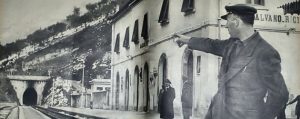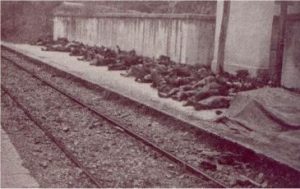One of the deadliest train disasters in railroad history occurred during World War II in Italy when over 500 people would suffocate to death. No one was held accountable for it.

3 March 1944, Unknown Author
Public Domain via Wikimedia Commons
It began simply enough. On the evening 2 March 1944 freight train 8017 left Salerno, Italy to a rural area south of the city. This required it to pass through the Galleria delle Amri Tunnel Pass just outside Balvano. Although a freight train, it was common for a lot of civilian and military people to hop on the next convenient train. By the time the train had reached Balvano, the last train stop between the two long tunnels in the Apennines Mountains. it had 650 people aboard. It reached the stop near midnight and had to stop for maintenance.
=
=
At ten minutes to 1 am, the train began its ascent into the Galleria delle Amri. The tunnel was poorly ventilated with 1.3% grade. Not long after entering the tunnel the train came to complete stop for 30 minutes. The exact reasons are still unclear. Either the train could not pull the overloaded freight cars, or it was waiting for another train to exit from the opposite direction. Some argue that humidity had caused the train wheels to slip, and sandboxes were not helping.
Unfortunately, due to wartime restrictions, the train was burning low grade coal which produced a lot of excess and odorless carbon monoxide.

5 March 1944, Author Unknown.
Public Domain via Wikimedia Commons
The train driver tried to reverse the train but fainted before he could accomplish it. An additional complication was that it was a two-locomotive set up. The driver in lead car could not communicate with the driver in the other one as they were not the same locomotive model. That driver was still trying to push forward. A brakeman walked back to Balvano getting there about 05:10. Quickly a locomotive was dispatched and got there by 05:25. It was too late. Many people had exited the freight cars hoping to find better air in the tunnel and died there. There were so any corpses on the rails prevented removal of the train. About 40 people in the last freight cars were alive. A second rescue mission at 08:40 was able to bring the train back to Balvano. The only train crew to survive was the brakeman and a fireman from the second locomotive.
Due to wartime restrictions, the US and Italians kept it out of the news. A commission was established to determine what happened. Blame was put on the low-quality coal and the station masters tolerating stowaways. The Italian railway company, Ferrovie dello Stato Italiane, declined all responsibility owing to the end of the war setup between the Italians and US. The Ministry of Treasury, in order to quell criticism, issued compensation to identified civilians (but it occurred 15 years later). A limitation on freight tonnage was introduced and the use of both diesel and steam locomotives for such routes were introduced, Steam engines were banned in 1959 and the line was electrified in 1996. Except for the train crew, the stowaways were buried in four common graves in Balvano cemetery.
Sources:
Sullivan, Missy. “More Than 500 Train Passengers Mysteriously Suffocate.” HISTORY, 28 Feb. 2024, www.history.com/this-day-in-history/train-passengers-suffocate.
Nag, Oishimaya Sen. “Deadliest Train &Amp; Railroad Accidents in History.” WorldAtlas, 25 Apr. 2017, www.worldatlas.com/articles/deadliest-train-and-railroad-accidents-in-history.html.
“ITALY: Death Train.” TIME.com, 2 Apr. 1951, content.time.com/time/subscriber/article/0,33009,814495,00.html.
“Balvano Train Disaster.” Wikipedia, 29 Feb. 2024, en.wikipedia.org/wiki/Balvano_train_disaster.
